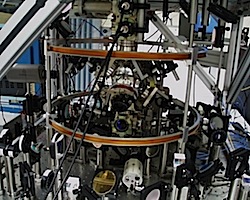To ensure safety, particularly as UAS become more common in the airspace, it’s critical to begin sharing individual satnav measurements as part of collision avoidance.
James L. Farrell, Vigil Inc.
Drone proliferation now amplifies expanded congestion of aircraft traffic in multiple ways. Some of those ways are unprecedented, including magnitude and speed of the increase, how it differs from previous expansions, increased challenge from rogues, a large and growing multitude of interference sources—in general, a greater degree of danger. Necessity’s role as the mother-of-invention may now be expanded to add mother-of-acceptance as well.
Since the dawn of aviation, air traffic control has been based on current position reports, and that historic dependence continues today. To stop overstressing collision avoidance (CA) capability, a marked change is advocated here.
Consider the utter simplicity of this reasoning:
• CA hinges on FUTURE (not present) distance from OTHER OBJECTS (not latitude, longitude).
• That future is the time of closest approach, e.g., a minute or two ahead.
• That knowledge is required to enable MODERATE evasive actions BEFORE closest approach.
• For those evasive actions to be effective, they must be based on accurate 3D dynamics.
• Today’s primitive “trail-of-bread-crumbs” gives inaccurate dynamics, unsuitable for CA.
• ADS-B remains wedded to a decades-old collision avoidance system (TCAS).
• TCAS made best use of the technology of its time, which gave accuracy along-range only.
• That basic limitation precludes evasion until emergency demands precipitous action.
• A strong alternative was validated by a flight test more than 10 years ago.
Even before unmanned aircraft systems (UAS), near-miss events and runway incursions gave warnings about increased air traffic. Work on this is extensively documented in books, presentations, columns and journals. As people with top qualifications continue to support these principLES, many principALS (i.e., decision-makers) decline to act (or in many cases, to respond after repeated contact). Today’s urgency no longer permits further delay; everything stated herein is readily understandable, requiring no expertise (the case is justified herein using no math beyond grade-school arithmetic), and logically fits as a complement to other important advances in air traffic management (ATM).
The Scope of the Problem
Focus is strictly maintained by concentrating on realistic comparison between prospective accuracy versus what exists now, while relying on external sources for what else is needed, which includes:
• dependable rejection of false signals
• an in-flight evasion guidance strategy capitalizing on that accuracy
AND by emphasizing what is NOT needed for success:
• requirements for new inventions
• generating concepts not yet in existence
Existing hardware and extended squitter message formats are acceptable. Just one caveat is acknowledged at the outset: dependence on satnav. Nothing else matches its availability and performance. Because the FAA currently prohibits acting on ADS-B data unless verified by satnav-independent information, concerns raised thereby are addressed as follows:
• Parallel efforts elsewhere actively pursue solutions for encryption and authentication.
• To guard against adverse usage, those efforts impose bandwidth demands.
• Changes described herein will add to, but not inordinately inflate, those demands.
• In addition to weak MEO signals, satnav in this context will include LEOs.
• LEO ephemeris errors are tolerable for relative navigation of aircraft in proximity.
Again for focus, no effort is made here to echo extensive coverage of stunningly brilliant accomplishments in other related areas (e.g., UAV development and control, NLOS data usage, imaging sensors at close range with favorable visibility, etc. ). Top priority missions (e.g., rescue, inspection, repairs at dangerous sites) have likewise received abundant description elsewhere; just identifying an adequate cross-section of relevant literature would be burdensome. Concentration will instead highlight one crucial facet: Using individual satnav measurements for CA, applicable to both manned and unmanned airborne vehicles. In particular, advances defined herein are derived from properties of the satnav carrier phase. Ambiguous phase cycle counts never have to be resolved because CHANGES over 1-second intervals offer the following traits not obtainable from other devices:
• Velocity dependence intrinsic to changes over the brief intervals.
• No limitation to one individual direction, because presence in each received satellite’s signals combine to offer three-dimensional operation.
• Precision (as verified with in-flight data for navigation [1,2] and tracking [3]; incremental values accurate to within a centimeter RMS were readily achieved).
• No restriction in range throughout any large collision-risk region.
The flight test previously mentioned [3] successfully used squitter messages with individual satnav measurements occupying the information bits rather than “positionING” with latitude and longitude.
Differential operation—inherently sensitive to relative information (i.e., expressing aircraft state with regard to other objects irrespective of lat/long)—then enabled capitalizing on the properties just listed, via well-known large error cancellation essential for CA (exceptions, e.g., from multipath or scintillation transients, are easily edited out).
Individual measurements, of course, enable usage of partial fix data and integrity testing. Position reporting offers none of these capabilities.
History of Advocacy
These issues are not suddenly being thrust on an industry unaware; far from being launched here, they have roots going back over four decades. Extensive bibliographies from an SAE report [4] and presentations (especially [5)] cordially received by the National Space-Based Positioning, Navigation, Timing Advisory Board include a host of documents urging change). Many highlight that seemingly unspectacular but vital step (measurement sharing); two of the better known (though not earliest) references are [6] and [7]. The latter unified in-air (3D) and surface (2D).
Also relevant to surface surveillance was a successful demonstration [8] at Logan airport. It capitalized on the crucial benefit of spontaneous broadcast [9] (as does ADS-B) though, as usual, transmitting location. Replacing that information with individual satellite data would have heightened that Logan airport success. The introduction in [7] listed eight incontestable reasons for superiority of individual measurements.
Instantly obvious from modern estimation, dire limitations of location pseudomeasurements for sensor integration were dramatically underlined in [10]. Discussion proceeds now to cite more quantitative results. For in-air CA, [11] shows speed adjustments to mitigate danger in crossing paths and [12] gives plots for various values of crossing angle and speed. In marked contrast to the emergency climb/dive maneuvers of TCAS, moderate speed changes suffice for many scenarios. The reason, as explained in [13], is they can begin well in advance. Climb/dives must wait until the last moment because TCAS can’t quantify needed cross-range estimates without air-to-air sightline rotation. That happens only at short range—precisely what CA is intended to avoid!
The danger has not gone unnoticed [14]. The SAE International EDGE report [4] cited in [15] from a 2021 National Space-Based Positioning, Navigation, Timing Advisory Board meeting expanded the scope with vital inputs from many of the best minds in our industry. Before that, the same board kindly allowed related presentations in 2015 [5] and 2018. There also has been support from other institutions, with opportunities for advocacy expressed in myriad ways for various reasons in different applications.
Basic Numerics
Without separation—from all other objects at all times—even the name “air traffic control” is a misnomer. Attention is thus drawn to CA, which highlights distance between ownship and another object at its closest approach time.
Placement of that event in the future establishes a demanding requirement for accurate knowledge of dynamics. With 100 seconds to closest approach and velocity error found in some ADS-B literature at 10 meters/sec, for example, apparent future separation has an error including a contribution from 100 * 10 meters in projected ownship/object distance producing a kilometer of uncertainty. Now, consider a thousandfold reduction achieved in the successful flight test [3] wherein 1 cm/sec velocity error was obtained, cutting that thousand meters to just one meter.
For each of two horizontal directions (north and east or along-range and cross-range) that’s a MILLION times less area of uncertainty projected forward. Higher-order dynamic effects would be even more pronounced. What’s needed can be furnished only by track files for all objects, repetitively updated, fed with accurate inputs (recall the stipulations regarding encryption and rejection of invalid data).
The algorithm used for processing (discussed in [16] with initial focus on radar, extended thereafter to satnav inputs used in differential mode) will yield three-dimensional vectors for relative position and derivatives (velocity at least). The GNSS measurements are described in chapter 46 part 2 of [1] or with further detail in [2]. Extending the flight test [3] to large numbers of participants is addressed in [4], with a far broader scope that benefited hugely from expert contributors.
Conclusion
Since the dawn of aviation, aircraft surveillance has relied primarily and heavily on instantaneous location reports. Invariably, the word “positioning” is inseparable from ATM concepts to this day. Unfortunately, a sequence of time-tagged locations to infer a flight path, so thoroughly ingrained, is fundamentally inadequate for congested skies (witness ADS-B’s loosely described velocity accuracy).
Advocacy for fundamental change was viewed as radical for decades. Rather than repetition here, several pertinent references are cited while summarizing key points: safety is paramount, demanding reliable CA, obtainable only via differential operation, which hinges on individual measurements—not provided by existing means of air traffic surveillance. With separation distance proportional to time until closest-approach, present position history cannot consistently enable accurate cross-range dynamics to be reliably determined in advance. For that reason, flight was becoming risky pre-COVID-19, let alone with future UAS traffic prospects.
Sharing measurements instead of coordinates has been a theme [6,17] of manuscripts starting well before this century began. TCAS, state-of-the-art when conceived pre-GPS, provides accuracy in only one direction (along-range) and applies in-air only. To detect and avoid all other objects—whether airborne or on ground, stationary or moving, discrete or part of a continuum below—with or without sudden violent maneuvers, sharing of individual measurements will be essential. A standard will evolve [18] to make that a reality.
Pilot projects should be initiated now to make up for lost time and preempt a crisis. Speed changes [12] cover crossing paths; other scenarios will call for turns. Guidance analysts, who established TCAS tracks from information primarily concentrated in one direction, would likely welcome an opportunity to develop strategies combining intent with high-accuracy three-dimensional data. Everything stated herein is also consistent with concerns noted in [14]. Material presented here and in cited references offers a strong beginning.
Digital flight rules, defined in William Cotton’s excellent 2021 National Space-Based Positioning, Navigation, Timing Advisory Board presentation [19], can be a vital part of the solution. Additional impressive advances in scope occurred at the Institute of Navigation’s September 2022 conference in Denver, addressing issues including wind [20], swarms [21] and LEOs [22].
References
Note from author: Many of these references were preceded by additional publications, too numerous to include here, plus two presentations (both gratis); one “brain-dump” to RTCA SC186 WG4 in 2000 and another to FAA’s ADSB chief with his two top advisers in 2006. The presentation meetings were cordial but did not result in adoption of the recommended change in ATM methodology.
(1) Jade Morton, Bradford W. Parkinson, James J. Spilker Jr., and Frank van Diggelen, (Eds.), Grace Gao, Sherman Lo (Assoc. Eds.) “Position Navigation & Timing technologies in the 21st Century”, Wiley-IEEE 2020 (Specific for this topic: Chapter 46, Part 2)
(2) Farrell, James L., GNSS Aided Navigation and Tracking, American Literary Press, 2007.
(3) Duan, Pengfei, De Haag, Maarten Uijt, Farrell, James L., “Flight Test Results of a Measurement-Based ADS-B System for Separation Assurance”, NAVIGATION, Journal of The Institute of Navigation, Vol. 60, No. 3, Fall 2013, pp. 221-234
(4) SAE International Report: “Unsettled Topics in the Application of Satellite Navigation to Air Traffic Management,” SAE EDGE Research Report, 2020 –https://saemobilus.sae.org/content/EPR2020010/ and https://www.sae.org/publications/technical-papers/content/epr2020010/
(5) Farrell, James L., “Raw Data to Improve Accuracy, Integrity, Availability of Satellite Navigation,” presentation to the National Space-Based Positioning, Navigation, Timing Advisory Board, Annapolis MD June 11, 2015 http://www.gps.gov/governance/advisory/meetings/2015-06/farrell.pdf
(6) Farrell, James L., and van Graas, Frank, “That All-Important Interface,” Proceedings of the 3rd International Technical Meeting of the Satellite Division of The Institute of Navigation (ION GPS 1990), Colorado Spring, CO, September 1990, pp. 457-460 https://jameslfarrell.com/wp-content/uploads/2010/06/IONGPS90.pdf
(7) https://doi.org/10.1002/j.2161-4296.1999.tb02407.x “Send Measurements, Not Coordinates”
(8) Bayliss, E. T., Boisvert, R. E., Knittel, G. H., “Demonstration of GPS Automatic Dependent Surveillance of Aircraft Using Spontaneous Mode S Broadcast Messages,” NAVIGATION, Journal of The Institute of Navigation, Vol. 41, No. 2, Summer 1994, pp. 187-206.
(9) von Sickle, G.A., “GPS for Military Surveillance,” GPS World, Nov 1996
(10) https://insidegnss.com/enabling-collision-avoidance-with-raw-measurements-and-updated-ads-b-software/
(11) “Aircraft Collision Avoidance” https://youtu.be/2X88s4o74c4
(12) https://mycoordinates.org/collision-avoidance-by-speed-change/ and https://jameslfarrell.com/wp-content/uploads/2013/08/IJUSEng-Collision-Avoidance.pdf
(13) “Air Traffic Control” https://youtu.be/84De8EM8S0U
(14) Post by Robert Charette on November 12, 2008 “THE RISK FACTOR: THE RISK OF MIDAIR COLLISION AND TCAS COLLISION-AVOIDANCE SYSTEMS: PART 1 https://spectrum.ieee.org/riskfactor/computing/it/the_risk_of_midair_collision_a_1
(15) https://youtu.be/C7jLRgDMq5E
(16) “Air-to-Air Tracking” https://youtu.be/DQcvAx0GYGk
(17) “Send Measurements, not Coordinates,” Institute of Navigation Quarterly Newsletter, Summer 2016, Volume 26 Number 3, pp. 14-15 (https://www.ion.org/publications/upload/v26n3.pdf)
(18) Farrell, James L., “Interface Requirements for SAE-Compliant GPS Receivers,” presentation to the National Space-Based Positioning, Navigation, Timing Advisory Board, Baltimore MD May 17, 2018, http://www.gps.gov/governance/advisory/meetings/2018-05/farrell.pdf
(19) Cotton , W.B. “Digital Flight Rules Enabled by GPS,” presentation to the National Space-Based Positioning, Navigation, Timing Advisory Board, Arlington VA, Dec 9, 2021, https://www.gps.gov/governance/advisory/meetings/2021-12/cotton.pdf
(20) Uijt de Haag, M. Ebert, C., Weiss, J. and Silvestre, F., “Navigation- and Energy-Aware UAV Trajectory Planning in a Windy Urban Environment,” Institute of Navigation Proceedings, Sept 2022, Denver CO, pp. 1760-1774
(22) Uijt de Haag, M. and Martens, M., “Cooperative sUAV Swarm Navigation for Urban Infrastructure Monitoring,”Institute of Navigation Proceedings, Sept 2022, Denver CO, pp. 2835-2848
(23) Morales, J. and Ardito, C., “Opportunistic Signal Acquisition and Tracking of Globalstar Low Earth Orbit Satellite Signals for Navigation,” https://www.ion.org/gnss/abstracts.cfm?paperID=11604
Author
James L. Farrell, MS, UCLA, Ph.D., University of Maryland, is a former ION Air Representative, Life Senior Member of IEEE, former local board member of AIAA, registered professional engineer in Maryland, and a member of various scholastic honorary fraternities. Technical experience includes teaching at Marquette and UCLA, two years each at Minneapolis Honeywell and Bendix-Pacific, and 31 years at Westinghouse in design/simulation/validation of nav-&-tracking programs. Author of INTEGRATED AIRCRAFT NAVIGATION (Academic Press 1976; in paperback after five hard-cover printings), and of GNSS AIDED NAVIGATION & TRACKING (2007; http://jameslfarrell.com/wp-content/uploads/2012/03/GPSINS.pdf) plus chapters in books edited by C.T. Leondes, Cary Spitzer, and Jade Morton/Brad Parkinson et. al. (GPS THEORY and APPLICATIONS; quarter-century update, 2021), plus over 100 journal/conference manuscripts or columns. With VIGIL Inc. he served as co-chair of RTCA’s GPS Integrity Working Group while consulting for private industry, DoD and university research. His main areas of recent activity are GPS/inertial integration, calibration, and integrity, (writing programs validated by in-flight data from Ohio University) plus 3D morphometrics. He is currently coordinating with SAE International on unsettled topics in ATM and integration.





